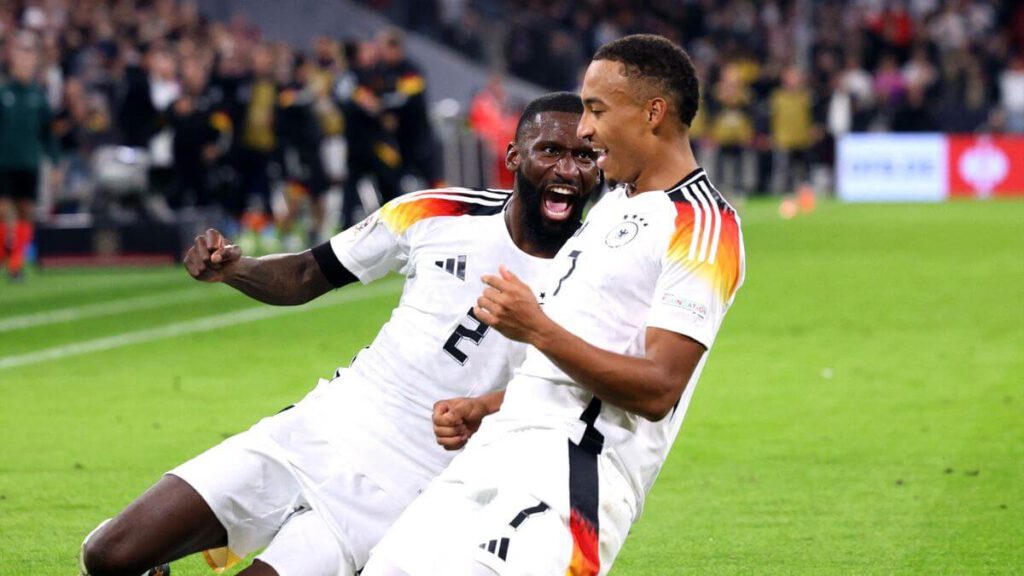Germany vs The Netherlands Tactical Analysis: 14 October 2024

The October 2024 clash between Germany vs The Netherlands highlighted some clear tactical challenges for both sides, particularly in the Netherlands’ camp. Missing critical figures like captain Virgil van Dijk and vice-captain Nathan Ake, who were absent due to a red card and an injury, respectively, the Dutch were forced to adapt defensively, with Jorell Hato making his debut and Mickey van de Ven and Stefan de Vrij playing as a duo for the first time. Additionally, midfielders Frenkie de Jong, Teun Koopmeiners, and Jerdy Schouten were sidelined due to injuries. Germany, too, missed key players: Jamal Musiala, Kai Havertz, Niclas Füllkrug, and goalkeeper Marc-André ter Stegen but still had the depth to exploit the Netherlands’ weakened lineup.
First Half: Defensive Struggles for The Netherlands
The Netherlands started defensively, sitting back in a 4-4-2 formation. However, they struggled with defensive intensity, leaving too much room for Germany to advance. Germany often found space to play into the pockets, moving the ball into dangerous areas and applying continuous high pressure. This aggressive press effectively boxed the Dutch into their own half, frequently forcing the ball back to the center-backs, who struggled to progress it forward.
Notably, the Dutch midfielders and attacking players Quinten Timber, Xavi Simons, and Liverpool’s Ryan Gravenberch and Cody Gakpo were often caught waiting for passes to their feet, limiting attacking options. This lack of depth and willingness to break past the German line made it difficult for the Dutch to find any rhythm or forward momentum.
Second Half: Germany Continued to Lead the Game
The Dutch saw slight improvement in the second half, particularly with the introduction of Donyell Malen, who brought a sense of dynamism and depth on the right flank. Mats Wieffer also made an impact from the number 6 position, providing more effective ball distribution and improving the Dutch transition game.
Despite these adjustments, Germany’s press continued to cause problems. The Netherlands couldn’t maintain possession under pressure, leading to frequent turnovers and limiting any real chances to test the German defense, only getting two shots in the direction of the German goal from Xavi Simons and Donyell Malen.
The Breakthrough: Germany’s Persistence Pays Off
After numerous attempts and a goal canceled for offside in the first minute, Germany finally broke through. A deflected opportunity fell perfectly to debutant Jamie Leweling, who calmly finished to give Germany a deserved 1-0 lead. The goal underscored Germany’s control and relentless pressure, while the Netherlands’ defense, though improved, ultimately couldn’t hold firm.
Tactical Key Points
- Substitutions: Malen and Wieffer brought some much-needed depth and distribution in the second half, but it wasn’t enough to overcome Germany’s dominance.
- Missing Leaders: The absence of Van Dijk, Ake, and de Jong left gaps in the Dutch setup, both in leadership and defensive organization.
- Formation and Pressure: The Dutch defensive 4-4-2 wasn’t intense enough in man-marking or pressing to disrupt Germany’s possession.
- Lack of Depth in Attack: Dutch players focused on receiving the ball to their feet rather than making runs in behind, leading to predictable attacks.
- German High Press: With the high press the Germans put on the Netherlands the whole game, there was little chances for the Dutch to get away from their own half.
- Replacing Key Players: Despite missing players like Jamal Musiala and Kai Havertz, Germany did well to adapt to the situation and showed a very good performance against a strong national team.
Final thoughts of Germany vs The Netherlands
This edition of Germany vs The Netherlands highlighted areas the Netherlands will need to work on to regain form in upcoming fixtures. Defensively, they’ll need to increase pressure, especially against high-caliber teams like Germany. In attack, finding a balance between positional play and depth is essential to create more diverse scoring options.
Germany’s ability to capitalize on the Netherlands’ defensive lapses, combined with their high pressing and control in midfield, proved decisive. This 1-0 victory will be seen as a tactical success for Germany, while the Dutch must use this as a learning experience to rebuild before their next game.

One response
[…] the opening 45 minutes, The Netherlands dominated possession with 70%, but Bosnia Herzegovina defended resolutely. Despite several attempts […]